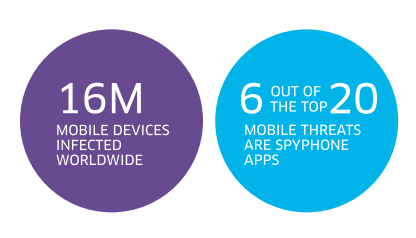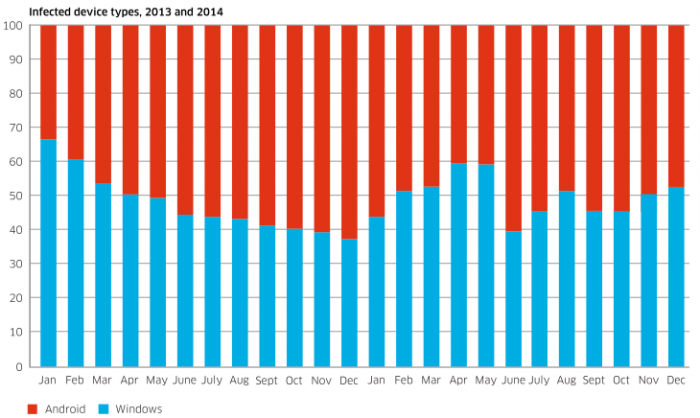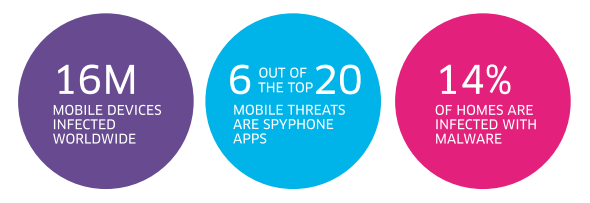Alcatel-Lucent’s security division, Motive Security Labs, has recently reported a 25% increase in mobile infection rates during 2014. The report estimates that 16 million mobile devices have been infected by malware worldwide, but perhaps the most concerning statistic is that Android devices have now caught up with Windows laptops, with infection rates between the two split 50/50 in 2014.
The report notes that the big increase in mobile infections is aided by the fact that a vast majority of mobile device owners do not take proper security precautions, relying on service providers to protect their mobile devices instead.
It also notes that cybercriminals are quick to take advantage of opportunities which are unique to the mobile ecosystem, with 6 of the top 20 most prevalent infections falling into the mobile spyware category. These are apps that are used to spy on the phone’s owner, tracking location as well as monitoring calls and text messages – functions unique to the mobile environment.
Motive Security Labs report highlights include:
- The mobile infection rate in 2014 is 0.68%. Based on this Alcatel-Lucent estimates that worldwide, about 16 million mobile devices are infected by malware.
- Mobile malware is increasing in sophistication with more robust command and control protocols
- Mobile spyware, used to spy on a phone’s owner, is also on the increase. It tracks the phone’s location, monitors ingoing and outgoing calls, text messages, e-mail and tracks web browsing.
- The overall monthly infection rate in residential fixed broadband networks is just under 14%. This is up substantially from the 9% seen in 2013. This is mostly attributable to an increase in infections by moderate threat level adware.
- High-level threats such as ‘bots’, ‘rootkits’, and ‘banking trojans’ remain steady at around 5%.
The report also includes the following predictions for 2015 (based on 2104 trends):
- Botnets move to mobile and the cloud
- Hactivism goes mobile
- Internet of things get hit
- Attacks on the cloud
The report plainly shows that, in this day and age, mobile device users need to be much more security conscious. While most PC users would not think of connecting to the net without some kind of antivirus software installed, unfortunately that is not the case with mobile device users.
- You can download the Motive Security Labs full report (PDF) here: Motive Security Labs report



Those are certainly stats I’d not argue with Jim, the mobile market has exploded and it’s a brand new playground for the malware developers to capitalise on. Does make one think however that the message of safety isn’t filtering through to mobile users!!
Well, Microsoft has the chance to laugh now. For years people have been blaming Microsofts shoddy writing skills for all the virus’s and such.
Now, it’s like I and many others have said, the bigger the market the more the exploits.
Windows had a vast majority in the market so it was a prime target. Now the other devices are becoming popular and in turn are also becoming targets.
If you look at percentages the exploits are fairly even across the board. Everything that can be exploited is being exploited. Apple is caught in this too, it just took longer due to how few there were to begin with. There is no such thing as an opperating system that is immune to hacking if someone puts their mind into hacking it.
Alan